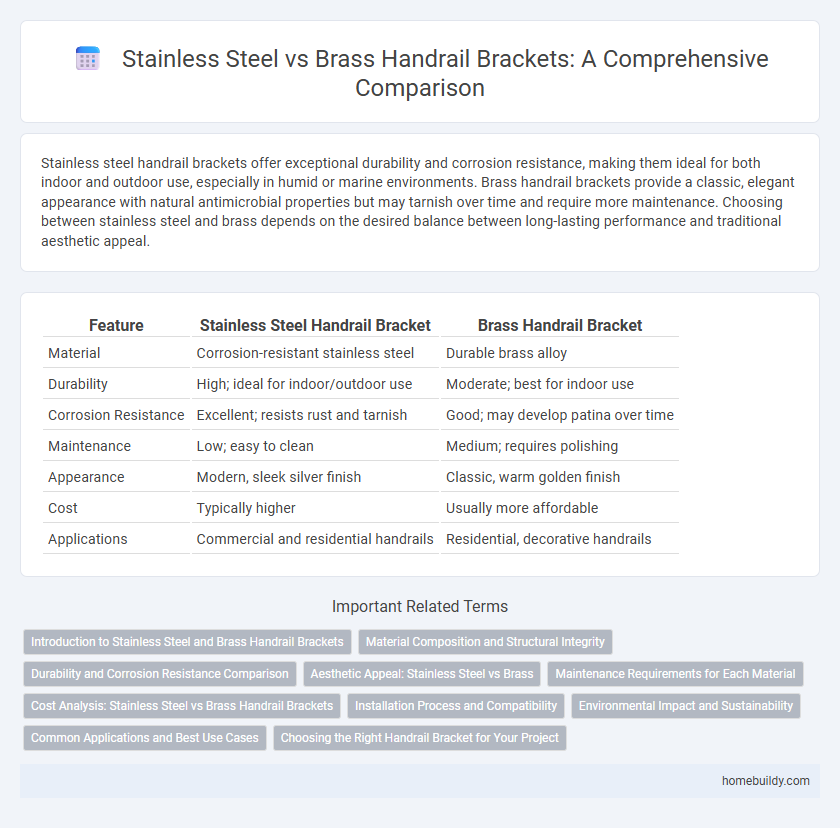Stainless steel handrail brackets offer exceptional durability and corrosion resistance, making them ideal for both indoor and outdoor use, especially in humid or marine environments. Brass handrail brackets provide a classic, elegant appearance with natural antimicrobial properties but may tarnish over time and require more maintenance. Choosing between stainless steel and brass depends on the desired balance between long-lasting performance and traditional aesthetic appeal.
Table of Comparison
| Feature | Stainless Steel Handrail Bracket | Brass Handrail Bracket |
|---|---|---|
| Material | Corrosion-resistant stainless steel | Durable brass alloy |
| Durability | High; ideal for indoor/outdoor use | Moderate; best for indoor use |
| Corrosion Resistance | Excellent; resists rust and tarnish | Good; may develop patina over time |
| Maintenance | Low; easy to clean | Medium; requires polishing |
| Appearance | Modern, sleek silver finish | Classic, warm golden finish |
| Cost | Typically higher | Usually more affordable |
| Applications | Commercial and residential handrails | Residential, decorative handrails |
Introduction to Stainless Steel and Brass Handrail Brackets
Stainless steel handrail brackets offer superior corrosion resistance and durability, making them ideal for both indoor and outdoor applications where longevity is critical. Brass handrail brackets provide a classic aesthetic with natural antimicrobial properties, often preferred in decorative or vintage architectural styles. Choosing between stainless steel and brass depends on factors like environmental exposure, maintenance requirements, and desired visual appeal.
Material Composition and Structural Integrity
Stainless steel handrail brackets offer superior corrosion resistance and enhanced durability due to their chromium-rich alloy composition, making them ideal for both indoor and outdoor applications. Brass handrail brackets, composed primarily of copper and zinc, provide excellent malleability and aesthetic appeal but are more prone to tarnishing and wear over time. The structural integrity of stainless steel brackets outperforms brass in high-stress environments, ensuring long-lasting support and safety in heavy-use settings.
Durability and Corrosion Resistance Comparison
Stainless steel handrail brackets offer superior durability and corrosion resistance, making them ideal for both indoor and outdoor applications in harsh environments. Brass handrail brackets provide a classic aesthetic with moderate corrosion resistance but are more susceptible to tarnishing and wear over time, especially in marine or high-humidity settings. Stainless steel grades such as 304 and 316 ensure long-lasting performance against rust and physical impact, outperforming brass in longevity and maintenance requirements.
Aesthetic Appeal: Stainless Steel vs Brass
Stainless steel handrail brackets offer a modern, sleek aesthetic with a smooth, reflective finish that complements contemporary architectural styles and resists tarnishing over time. Brass handrail brackets provide a warm, classic appeal with their rich golden hue and natural patina development, ideal for vintage or traditional interiors seeking character and elegance. Choosing between stainless steel and brass balances durability with the desired visual impact in a space's design scheme.
Maintenance Requirements for Each Material
Stainless steel handrail brackets require minimal maintenance due to their resistance to rust, corrosion, and discoloration, making them ideal for high-moisture environments. Brass handrail brackets demand regular polishing to prevent tarnishing and maintain their aesthetic appeal, as they are more susceptible to oxidation over time. Choosing stainless steel reduces the frequency of upkeep, while brass offers a classic look at the cost of increased maintenance efforts.
Cost Analysis: Stainless Steel vs Brass Handrail Brackets
Stainless steel handrail brackets typically cost less upfront compared to brass brackets, offering a more affordable option for large-scale projects. Brass handrail brackets, while more expensive, provide superior corrosion resistance and a classic aesthetic that may justify the higher initial investment in long-term maintenance savings. Evaluating cost-effectiveness involves comparing initial purchase prices with durability and potential replacement expenses over time.
Installation Process and Compatibility
Stainless steel handrail brackets offer superior corrosion resistance, making them ideal for both indoor and outdoor installations, particularly in humid or coastal environments, and they typically require standard screws and anchors compatible with most wall types. Brass handrail brackets provide a classic aesthetic and work well in dry, indoor settings but may need specialized fasteners to prevent damage during installation and ensure secure mounting on wood or masonry surfaces. Compatibility with different handrail materials and wall substrates varies, with stainless steel brackets generally offering broader adaptability due to their strength and resistance to environmental factors.
Environmental Impact and Sustainability
Stainless steel handrail brackets offer superior environmental sustainability due to their high recyclability rate of over 90% and longer lifespan, reducing the need for frequent replacements. Brass handrail brackets, while durable, involve mining of copper and zinc which generates higher environmental pollution and energy consumption during extraction and processing. Choosing stainless steel brackets supports eco-friendly construction practices by minimizing waste and lowering carbon emissions throughout the product lifecycle.
Common Applications and Best Use Cases
Stainless steel handrail brackets are ideal for outdoor and high-moisture environments due to their corrosion resistance and durability, commonly used in commercial buildings, staircases, and marine applications. Brass handrail brackets offer a classic aesthetic and moderate corrosion resistance, making them suitable for indoor settings like residential staircases, decorative railings, and historical restorations. Choosing between stainless steel and brass depends on exposure conditions and design preferences, with stainless steel excelling in longevity and brass in visual appeal.
Choosing the Right Handrail Bracket for Your Project
Stainless steel handrail brackets offer superior corrosion resistance and durability, making them ideal for outdoor or high-moisture environments compared to brass handrail brackets, which provide a classic aesthetic but may tarnish over time. Brass brackets excel in decorative indoor applications where visual appeal and traditional style are priorities. Selecting the right handrail bracket depends on balancing environmental conditions, maintenance needs, and design preferences to ensure longevity and functionality.
stainless steel handrail bracket vs brass handrail bracket Infographic

 homebuildy.com
homebuildy.com